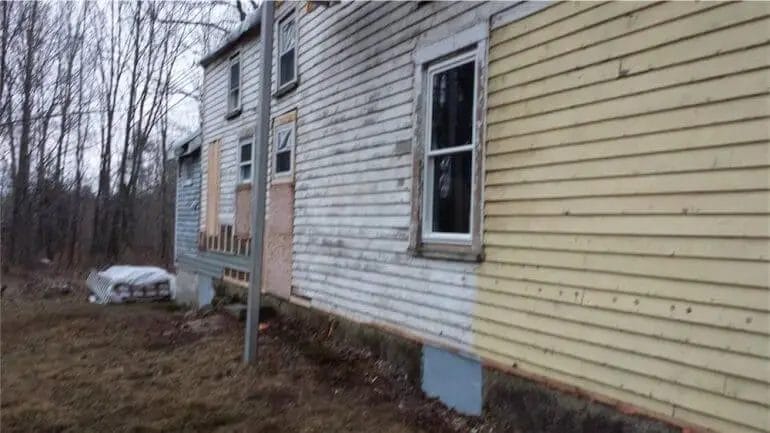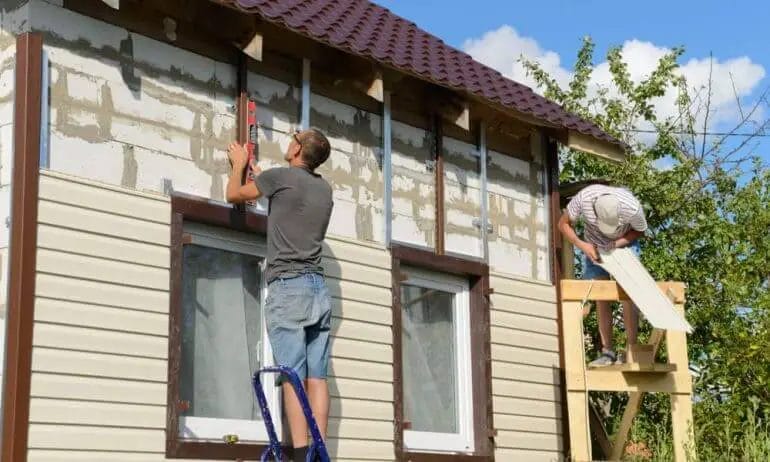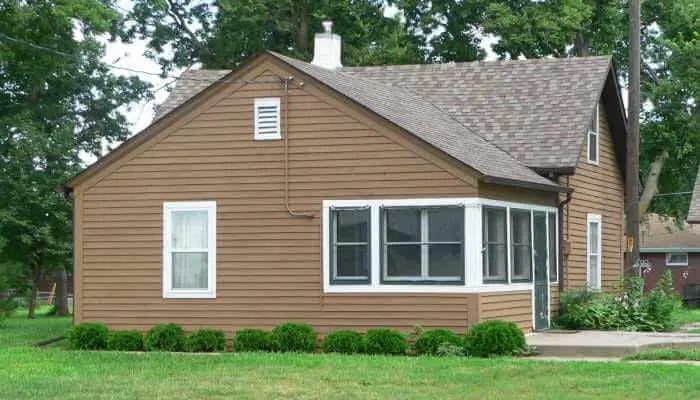Yes, it is possible to install vinyl siding over existing wood siding. This is a popular option for homeowners who want to update the appearance of their home without the hassle of removing the old siding. By installing vinyl siding over wood siding, you can give your home a fresh, modern look while also improving its energy efficiency and durability.
However, there are a few important considerations to keep in mind. First, the wood siding must be in good condition and properly prepared for the installation of vinyl siding. Any rot or damage should be repaired before proceeding. Additionally, the thickness of the wood siding may affect the overall dimensions of the wall, so adjustments may be necessary.

Before installing vinyl siding over wood siding, it is recommended to consult with a professional contractor who can assess your specific situation and provide expert guidance. They can help ensure that the installation process is done correctly, resulting in a beautiful and long-lasting finish for your home.

Steps to Properly Install Vinyl Siding over Wood Siding
When it comes to home improvement projects, vinyl siding installation can be a great way to enhance the look and durability of your home. If you already have wood siding and want to switch to vinyl siding, you may be wondering how to properly install it. In this section, we will outline the step-by-step process to help you install vinyl siding over wood siding effectively.
Step 1: Prepare the Area
Before you begin the installation process, you need to prepare the area by removing any obstacles or debris. Clear the area of any plants, furniture, or decorations that may hinder the installation process. It is also essential to inspect the wood siding for any damage and make necessary repairs before proceeding.
Step 2: Measure and Order the Materials
Accurate measurements are crucial to ensure that you order the right amount of vinyl siding and other necessary materials. Measure the height and width of the walls to calculate the square footage. This will help you determine the quantity of vinyl siding, starter strips, J-channels, and other accessories needed for the installation.
Step 3: Install the Starter Strips
The starter strips are the foundation for your vinyl siding installation. They help create a level starting point and secure the bottom row of siding. Install the starter strips along the bottom edge of the wall, ensuring they are level and properly aligned.
Step 4: Attach the J-Channels
J-channels are used to receive the cut edges of the siding and provide a clean, finished look. Install the J-channels around windows, doors, corners, and other areas where the siding will be trimmed. Make sure they are securely fastened and level.
Step 5: Install the Vinyl Siding Panels
Starting from the bottom, install the vinyl siding panels by sliding them into the starter strips and locking them into place. Use a nail or screw to secure each panel to the wall, but make sure not to drive the fasteners too tightly to allow for expansion and contraction of the vinyl during temperature changes.
Step 6: Trim and Fit the Siding
Trim the siding panels to fit around windows, corners, and other obstructions. Use a utility knife or vinyl siding snips to make clean and precise cuts. Ensure a proper fit by leaving a small gap between the siding and any adjacent structures to account for expansion.
Step 7: Install the Accessories
Finish the installation by adding the necessary accessories, such as corner posts, window trims, and soffit panels. These accessories will enhance the overall appearance and ensure a professional finish.
Step 8: Clean and Inspect
Once the installation is complete, clean the vinyl siding with a mild detergent and water solution to remove any dirt or debris. Inspect the entire installation for any loose or damaged panels, and make any necessary adjustments or repairs.
In summary, installing vinyl siding over wood siding can be a great way to upgrade the exterior of your home. By following these step-by-step instructions, you can ensure a proper installation that will enhance the durability and appearance of your home for years to come.

Common Challenges and Solutions when Installing Vinyl Siding over Wood Siding
When it comes to home improvement, installing vinyl siding over wood siding has become a popular option for many homeowners. Not only does it enhance the appearance of the house, but it also provides better insulation and requires less maintenance. However, there are some common challenges that may arise during the installation process. In this section, we will discuss these challenges and provide practical solutions to overcome them.
1. Uneven Surface
One of the main challenges when installing vinyl siding over wood siding is dealing with an uneven surface. Wood siding may have imperfections, such as dents, bumps, or gaps, which can affect the installation of vinyl siding and compromise its durability.
Solution: Before installing vinyl siding, it is essential to prepare the surface properly. Start by inspecting the wood siding and repairing any damage or uneven areas. Fill in gaps and holes with appropriate wood filler and sand down any high spots. By ensuring a smooth and level surface, you can prevent future issues and achieve a better installation result.
2. Moisture and Rot
Moisture and rot are significant concerns when installing vinyl siding over wood siding. If the underlying wood is already damaged by moisture or rot, it can affect the integrity of the vinyl siding and lead to further issues down the line.
Solution: Before installing vinyl siding, it is crucial to thoroughly inspect the existing wood siding for signs of moisture or rot. If any areas are affected, they should be replaced or repaired before proceeding with the vinyl siding installation. Additionally, consider adding a moisture barrier or house wrap beneath the vinyl siding to provide an extra layer of protection against moisture infiltration.
3. Proper Insulation
An important aspect of installing vinyl siding is ensuring proper insulation. Without adequate insulation, the house may be prone to heat loss, resulting in increased energy consumption and higher utility bills.
Solution: Before installing vinyl siding, consider adding insulation to the exterior walls. This can be done by installing foam board insulation or using an insulating underlayment beneath the siding. Proper insulation will not only improve energy efficiency but also enhance the overall comfort of the home.
4. Exterior Trims and Accessories
Installing vinyl siding may require additional work when it comes to exterior trims and accessories. It is essential to ensure that these elements are properly installed and aligned with the vinyl siding for a seamless and professional-looking finish.
Solution: Take the time to measure and plan the installation of exterior trims and accessories before installing the vinyl siding. Use appropriate tools and techniques to cut and shape the trims according to the desired design. Properly align and secure the trims to ensure a cohesive look that complements the vinyl siding installation.
5. Follow Manufacturer Guidelines
Lastly, it is crucial to follow the guidelines provided by the vinyl siding manufacturer. Each manufacturer may have specific requirements and recommendations for installation, which should be followed to ensure optimal performance and longevity of the vinyl siding.
Solution: Before starting the installation process, thoroughly read and understand the manufacturer’s instructions and guidelines. Follow the recommended steps for preparing the surface, installing the siding panels, and securing them properly. Adhering to these guidelines will help prevent common installation mistakes and ensure a successful outcome.
Summary
Installing vinyl siding over wood siding can be a transformative home improvement project. However, it is essential to address common challenges such as uneven surfaces, moisture and rot issues, proper insulation, exterior trims, and following manufacturer guidelines. By addressing these challenges and implementing the suggested solutions, homeowners can achieve a durable, visually appealing, and energy-efficient vinyl siding installation.

Expert Tips for Maintaining Vinyl Siding Installed over Wood Siding
When it comes to home exteriors, vinyl siding has become a popular choice among homeowners. It offers a durable, low-maintenance solution that can enhance the aesthetics of any property. If you have vinyl siding installed over wood siding, it is important to take proper care of it to ensure its longevity and appearance. In this section, we will provide you with some expert tips for maintaining vinyl siding installed over wood siding.
1. Regular Cleaning
One of the key aspects of maintaining vinyl siding is regular cleaning. This helps to prevent dirt, grime, and other pollutants from building up and causing damage over time. You can use a soft brush or a pressure washer on a gentle setting to clean the siding. Be sure to spray the water at a downward angle to avoid getting water behind the siding, which can lead to moisture damage.
2. Inspect for Damage
Regular inspections are essential to catch any signs of damage early on. Check for any cracks, chips, or punctures in the vinyl siding. If you notice any damage, it is important to address it promptly to prevent further issues. You can repair minor damage using a vinyl siding repair kit or contact a professional if the damage is extensive.
3. Trim Overhanging Trees
If you have trees near your home, make sure to trim any overhanging branches that may come into contact with the vinyl siding. Tree branches can scratch or dent the siding, compromising its integrity. By keeping the trees trimmed, you can prevent unnecessary damage and prolong the lifespan of your vinyl siding.
4. Prevent Moisture Buildup
Moisture can be a common enemy for wood siding. To prevent moisture buildup behind the vinyl siding, ensure that the wood siding underneath is properly sealed and insulated. This will help to minimize the risk of mold, mildew, and rot. Additionally, make sure that the gutters and downspouts are clear of debris to prevent water from overflowing and seeping behind the siding.
5. Avoid Harsh Chemicals
When cleaning your vinyl siding, avoid using harsh chemicals or abrasive cleaners. These can damage the siding and affect its color and finish. Instead, opt for mild soapy water or a vinyl siding cleaning solution recommended by the manufacturer. Use a soft cloth or sponge to gently scrub the siding and rinse thoroughly with clean water.
6. Address Fading or Discoloration
Over time, vinyl siding can fade or become discolored due to exposure to sunlight and other environmental factors. If you notice significant fading or discoloration, you may consider applying a vinyl siding restorer or contacting a professional to restore its original appearance. This can help to maintain the aesthetic appeal of your home.
7. Consider Professional Inspection and Maintenance
While regular maintenance tasks can be performed by homeowners, it is also beneficial to schedule professional inspection and maintenance periodically. A professional can identify any underlying issues and provide recommendations for repairs or improvements. Investing in professional maintenance can help to extend the lifespan of your vinyl siding and ensure its optimal performance.
In summary, maintaining vinyl siding installed over wood siding requires regular cleaning, inspection for damage, trimming overhanging trees, preventing moisture buildup, avoiding harsh chemicals, addressing fading or discoloration, and considering professional inspection and maintenance. By following these expert tips, you can keep your vinyl siding in excellent condition and enjoy its benefits for years to come.
Cost Comparison: Vinyl Siding vs Wood Siding for Home Exterior
When it comes to choosing the right siding material for your home’s exterior, two popular options that often come up are vinyl siding and wood siding. Both options have their own unique advantages and disadvantages, but one important factor that many homeowners consider is the cost. In this section, we will compare the cost of vinyl siding and wood siding to help you make an informed decision for your home.
Vinyl Siding
Vinyl siding is a synthetic material that is made from PVC (polyvinyl chloride) resin. It is known for its durability, low maintenance requirements, and wide range of color choices. Here is a breakdown of the cost factors associated with vinyl siding:
- Material Cost: Vinyl siding typically costs less than wood siding in terms of material expenses. The cost can vary depending on the quality and thickness of the vinyl, as well as the color and texture options. On average, you can expect to pay around $2 to $7 per square foot for vinyl siding.
- Installation Cost: The installation cost of vinyl siding is generally lower compared to wood siding. Vinyl siding is lightweight and easy to install, which can help reduce labor costs. The average cost for professional installation of vinyl siding ranges from $3 to $8 per square foot.
- Maintenance Cost: One of the major advantages of vinyl siding is its low maintenance requirements. Unlike wood siding, vinyl siding does not need to be painted or stained and can be cleaned with a simple wash using a hose. This can save you money on maintenance and upkeep over time.
In summary, vinyl siding offers a relatively affordable option for homeowners who are looking for a durable and low-maintenance siding material.
Wood Siding
Wood siding has a classic and natural appeal that many homeowners find attractive. It is available in various styles, including clapboard, shingles, and shakes. Here is a breakdown of the cost factors associated with wood siding:
- Material Cost: Wood siding tends to be more expensive than vinyl siding in terms of material cost. The price can vary depending on the type of wood chosen, with cedar and redwood being among the pricier options. On average, you can expect to pay between $5 to $12 per square foot for wood siding.
- Installation Cost: The installation cost of wood siding is generally higher compared to vinyl siding. Wood siding requires more labor and expertise to install properly, which can increase the overall cost. The average cost for professional installation of wood siding ranges from $6 to $12 per square foot.
- Maintenance Cost: Wood siding requires regular maintenance to keep it in good condition. This includes painting or staining every few years to protect the wood from moisture and UV damage. The cost of maintenance can add up over time, both in terms of time and money.
In summary, while wood siding offers a timeless and natural aesthetic, it comes with a higher price tag and requires more maintenance compared to vinyl siding.
When it comes to the cost comparison between vinyl siding and wood siding, vinyl siding generally offers a more affordable option. It has a lower material cost, easier installation process, and requires less maintenance. However, it’s important to consider other factors such as the desired aesthetic, durability, and climate suitability before making a final decision for your home’s exterior.
FAQs
Can you put vinyl siding over wood siding?
Yes, it is possible to install vinyl siding over wood siding. However, it is important to ensure that the wood siding is in good condition and properly prepared before installing vinyl siding over it. Additionally, it is recommended to consult with a professional to ensure proper installation.
Conclusion
In summary, the decision to put vinyl siding over wood siding can greatly enhance the aesthetics and durability of your home. By opting for vinyl siding, you can enjoy a low-maintenance solution that offers excellent insulation and protection against the elements.
However, it is essential to consider the condition of your existing wood siding before proceeding. Inspecting for rot, damage, and ensuring a smooth surface is crucial to ensure a successful installation. Consulting with a professional contractor will help you determine if your wood siding is suitable for an overlay.
Ultimately, choosing vinyl siding offers a cost-effective and sustainable solution that can transform the appearance of your home while reducing the need for regular upkeep. Enjoy a beautiful and long-lasting exterior with vinyl siding!